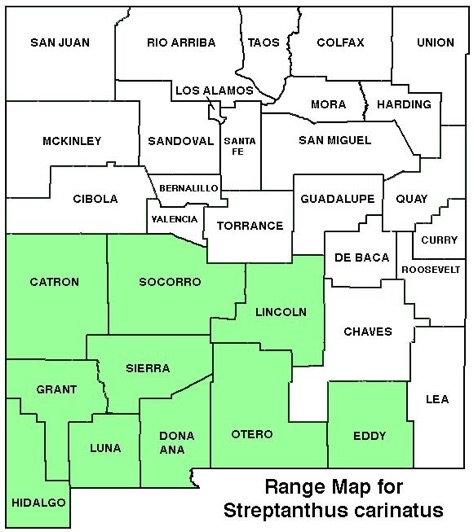WILDFLOWERS OF NEW MEXICO

The unusual, urn-shaped flowers of this plant bloom in a spike on erect, 1–3-foot tall stems. Unsatisfied with only one color, flowers vary from pearly- or greenish-white to yellow, rusty red, or purple. Note the triangular stem leaves clasp the stem and taper to a point.
FLOWERS: March–April. Urn-shaped flowers have petal-like sepals with 4 ribs, 1/2 inch long (12 mm); 4 tiny petals protrude from the tip and curl outward with the throat nearly closed. Fruit is a thin, cylindrical capsule (silique), 1 1/8–3 1/8 inches long (3–8 cm), that angles upward.
LEAVES: Basal leaves oblong to lobed, reach 4 inches long (10 cm), tip pointed. Alternate stem leaves entire, smooth, gray-green, long-triangular with tapering, pointed tips; leaf bases clasp the stems; upper leaves get smaller.
HABITAT: Sandy, gravelly, clay-loam, granite, limestone soils, canyons, foothills; desert grasslands and shrub.
ELEVATION: 2,500–7,000 feet.
RANGE: AZ, NM, TX.
SIMILAR SPECIES: According to Flora Neomexicana IIIa (Allred), 2 subspecies of S. carniatus grow in NM. Subsp. arizonicus has white or yellow flowers, while subsp. carinatus has reddish-purple flowers. Two other species of jewelflower grow in NM, one with urn-shaped flowers and fruit that angle up. Heartleaf Twistflower, S. cordatus, in the Four Corners region, has heart-shaped basal leaves and purple-tipped petals. Related genre have fruit that angle down and flowers that open wider.
NM COUNTIES: Southern half of NM, excluding eastern plains, in low- to mid-elevation, dry habitats: Catron, Dona Ana, Eddy, Grant, Hidalgo, Lincoln, Luna, Otero, Sierra, Socorro.
NOTES: Besides their color variety, the jewelflower is an anomaly in the mustard family. Unlike other mustards with four symmetrical petals, jewelfowers have urn-shaped, specialized flowers. The sepals are the showy part with the white petals marked with nectar guidelines barely protruding and curling backwards.
Their pollination strategy, protandry, is also an anomaly for the mustards. In protandrous flowers, the male parts (anthers with pollen) mature before the female parts (ovary and stigma). This prohibits self-pollination. In jewelflowers, the flowers are almost an inch apart on the stalk with one maturing at a time, another protection against self-fertilization. The anthers mature and develop pollen and block the narrow flower throat, with the stigma at the bottom. Though no nectar is available, the flower emits a sweet odor to attract pollinators to gather pollen. When the anthers dry up, the flower throat is accessible and the ovary and stigma develop. Only then does the flower begin to produce nectar to attract and reward pollinators.

LYRELEAF JEWELFLOWER, TWISTFLOWER
STREPTANTHUS CARINATUS
Brassicaceae, Mustard Family
Annual herb


THE CONTENTS OF THIS WEBSITE ARE COPYRIGHTED AND CANNOT BE USED
WITHOUT PERMISSION OF GEORGE OXFORD MILLER

-
•4 petals extend from the tip and curl outward (upper arrow).
-
•Sepals (lower arrow) may be yellow, white, or rusty red.





Basal leaves are oblong to lobed. Stem leaves are clasping
The fruit is a thin, cylindrical capsule (silique) that angles upward.

EMAIL ME

